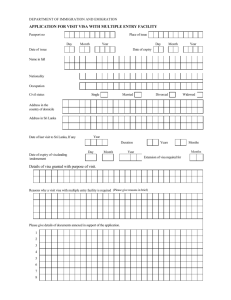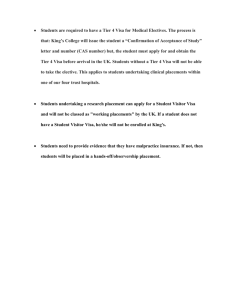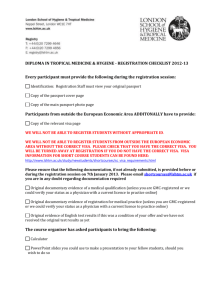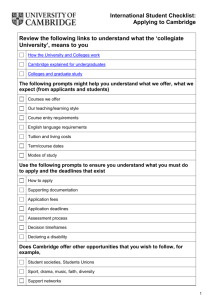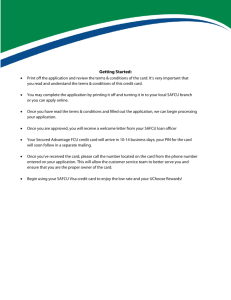FYBA Crew Visa Presentation October 1, 2014
advertisement
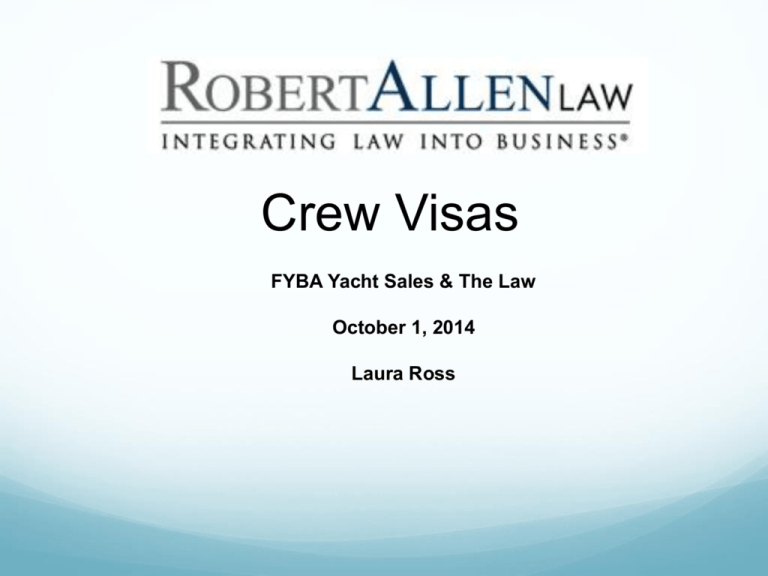
Crew Visas FYBA Yacht Sales & The Law October 1, 2014 Laura Ross Who needs a visa? All crew and passengers need a visa to enter U.S. waters (includes Alaska, Hawaii, Puerto Rico, Guam, American Samoa and the Virgin Islands of the United States). All vessels sailing in the Caribbean should have U.S. visas. In the event the vessel needs to stop for repairs or gas in the U.S. Virgin Islands all passengers will need a visa to enter U.S. waters Definition of “Crew” All employees on board a ship whose services are required for normal operation while traveling to the U.S. Includes captain, mates, chef, chemist, electrician, beautician, lifeguard, etc. It is immaterial whether such alien is employed by the owners of the vessel or by a management company All foreign crew working aboard a vessel that will enter the U.S. must have a visa. Crew members from countries that participate in the visa waiver program (VWP) (e.g. Italy, Germany, etc.) still need a visa!!! Two Types of Visas For Crew D Crew Visa; or B1 Visa D Crew Visa Allows for the visa holder to enter the U.S. for up to 29 days Required for all commercial vessels Excludes U.S. based fishing vessels (consider H-2 option) D visa requires that crew meet the vessel abroad and enter the U.S on board the vessel. If the crew will travel to the U.S. to join the vessel they will need a transit visa (c visa). The consular officer will need a verifying letter from the employer to issue the c-1 visa. Consular officer may issue a crewman D visa concurrently with a c-1 visa for use in future applications for admission D visa/29 Day Requirement To qualify for D status, crewmen must intend to depart the US with the vessel on which they arrived or some other vessel within 29 days at any one time Departure = vessel must sail from the US destined to a foreign port or place and clear a foreign port. Travel to international waters is not enough. Most Common Visa for Crew: B-1 Visa Members of the crew of a private yacht sailing out of a foreign port which will be cruising in U.S. waters for more than 29 days must be documented with a B-1 visa If the primary service crew will perform is related to dry dock repairs while the boat is docked at a U.S. port they must be documented with a B-1 visa B1 Visa for Crew Requirements B-1 visa requires the applicant to establish: Residence abroad which they do not intend to abandon; Intend to enter the U.S. for a period of limited duration; and Seek admission for the sole purpose of engaging in legitimate activities relating to business or pleasure (1) Residence Abroad/Ties Abroad Requirement The term “residence” is defined as “the place of general abode - his principal, actual dwelling place in fact, without regard to intent.” Can be difficult to establish if a crewmember has worked on a vessel for years; Documents used to establish residence may be hard to find for crew living on vessels (e.g. tax documents, bank account statements, lease agreements, mail etc.) Ties abroad (family, business, financial, etc.) (2) Period of Limited Duration Period of time must be consistent with purpose of the trip – cannot be indefinite in nature “Temporary” period of stay requirement – crew often have no control over the length of their U.S. visit. (3) Seek Admission for Legitimate Activity B1 visa is not intended for the purpose of obtaining and engaging in employment in the US Valid business reasons incidental to work that will principally be performed outside the US An individual in B1 status does not have employment authorization and the client should be advised of the prohibition of “employment” “Employment” is considered “any service or labor performed in the US by an individual, other than an independent contractor, for wages or other remuneration, where “remuneration” is defined as “some kind of payment or exchange in kind of a person for a service, loss or expense.” Limitations of B1 Visa Visa holder is restricted to working for a foreign company on a foreign flagged ship and must be paid by a foreign source Source of salary must be from abroad. Visa holder may not receive a salary from a U.S. source for services rendered in connection with his or her activities in the U.S. A U.S. source, however, may provide the alien with an expense allowance or reimbursement for expenses incidental to the temporary stay (incidental expenses may not exceed the actual reasonable expenses the alien incurred in traveling to and from the event, living expenses for lodging, meals and other basic services). See 9 FAM 41.31 N11 (2014). Limitations of B1 Visas (Continued) Paying crew members on a B1 visa from a U.S. bank account may create problems with obtaining or renewing B1 visas in the future because of the source of the salary. B-1 activities must be incidental to work that will principally be performed outside of the United States Crewmen on a commercial yacht are not eligible (e.g. if the vessel enters U.S. waters for the purpose of chartering the vessel) How to Apply for B1 Visa: 1) Create account on usvisa-info.com 2) Pay Nonimmigrant (MRV) fee 3) Schedule Appointment with Consulate Best place to apply for the first B1 visa is the home country consulate Renewals can be done in third party consulates depending on reciprocity B Visa Issuance Consular Level Challenges Visa is applied for at the US embassy or consulate Preference is for the consulate in the country of origin so documents do not need to be translated to English – which can be costly. Some consular officers do not understand crew visas and B1 visas for crew and incorrectly issue the wrong visa (e.g. D visa without C transit visa) Visa v. Status . . . • Visa will be valid according to the reciprocity schedule between the United States and the country of origin • The only act to which the visa entitles the visa holder is to travel to a US POE and ask to be admitted to the United States • If the visa holder is admitted to the US the visa becomes insignificant and now the visa holder has “status” Visa v. Status (Continued) At the time of admission, the visa holder is issued an I94 stamp that will show the traveler’s entry date, immigration status and the expiration of the date of the status The status does not end when the visa expires Visa v. Status (Continued) Length of time granted on I-94 is decided by CBP. Typically 6/12 month increments. CBP has the discretion to issue the I-94 for shorter periods 6 month and 3 month stays are now common Often determined by the amount of time visa holder has already spent in the US Crew/Status . . . Different crew members granted different durations of status Renewal I-539 Application to Extend; or Leave and reenter the United States Crew/Status . . . Failure to maintain status may result in: Deportation Ineligibility to change or extend nonimmigrant status Ineligibility for adjustment of status Overstays are likely to experience heightened scrutiny when applying for future visas at the US Consulate in their country of nationality Inadmissibility to the US 180 - 364 day overstay = inadmissible for 3 years +365 day overstay = inadmissible for 10 years BON VOYAGE! C’EST TOUT!
